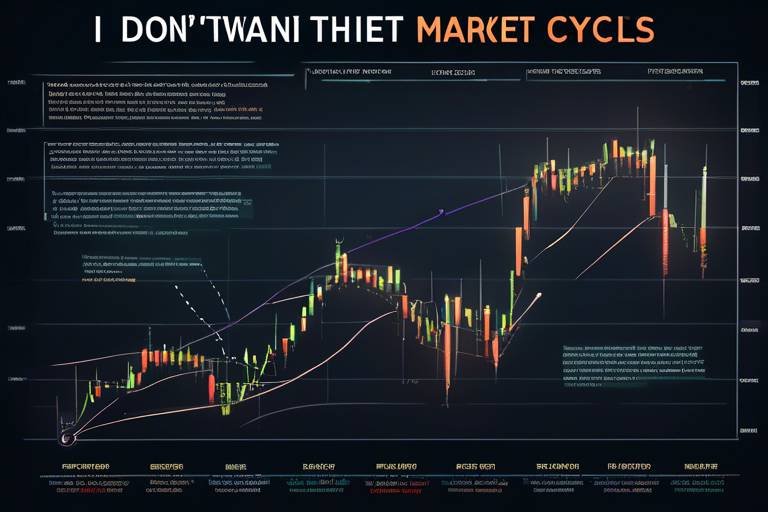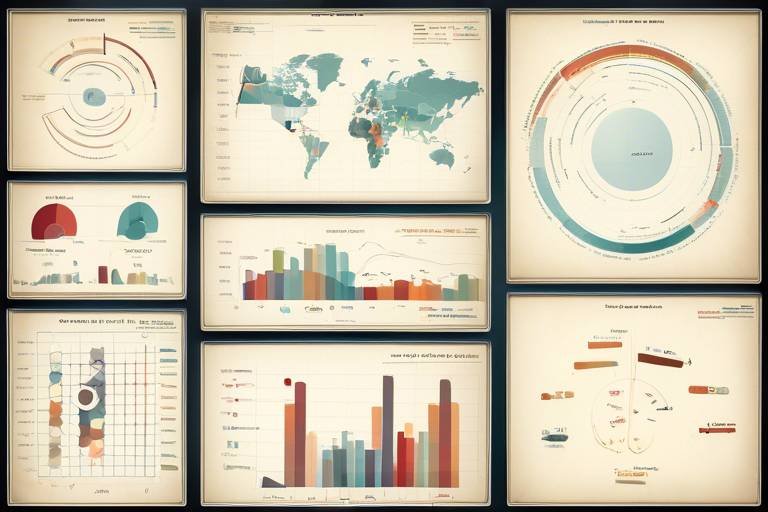Tips for Trading with High Volatility
Welcome to the thrilling world of trading! If you’re here, you’re likely looking to conquer the challenges that come with high volatility in the financial markets. Volatility can feel like riding a roller coaster—one moment you’re soaring high, and the next, you’re plunging down. But don’t worry! With the right strategies, you can turn those wild price swings into profitable opportunities. In this article, we’ll explore essential tips and insights to help you navigate through these turbulent waters and emerge victorious.
So, what exactly is volatility? In simple terms, volatility represents the degree of variation in trading prices over time. It’s like the heartbeat of the market—sometimes it beats fast, and other times it slows down. Understanding volatility is crucial for traders, as it can significantly impact your trading decisions and risk management strategies. When markets are volatile, prices can change rapidly, creating both risks and opportunities. If you’re not prepared, you might find yourself caught off guard, like a deer in headlights. But fear not! With the right knowledge, you can make informed decisions that keep you ahead of the game.
When it comes to trading in high volatility, implementing robust risk management strategies is vital. Think of risk management as your safety net; it protects your capital and minimizes potential losses. Without it, you might find yourself in a precarious situation, like walking a tightrope without a safety harness. Here are a few techniques to consider:
- Setting Stop-Loss Orders: These are essential tools for limiting potential losses. They act like a safety valve, ensuring you exit a trade before losses escalate.
- Position Sizing Techniques: Proper position sizing helps manage your risk and exposure. It’s like deciding how much weight to lift at the gym—too much can lead to injury!
Stop-loss orders are your best friends in volatile markets. They allow you to set a predetermined price at which your position will automatically close, limiting your losses. However, setting and adjusting stop-loss levels effectively during volatile conditions can be tricky. You don’t want to set them too tight, or you risk getting stopped out prematurely; too loose, and you might suffer significant losses. The key is to find that sweet spot!
Let’s dive into the different types of stop-loss orders you can use:
| Type | Description | Effectiveness |
|---|---|---|
| Market Stop-Loss | Closes your position at the current market price once triggered. | High |
| Limit Stop-Loss | Sets a specific price at which you want to exit, but only if the market reaches that price. | Medium |
| Trailing Stop-Loss | Moves with the market price, locking in profits while limiting losses. | High |
Adjusting your stop-loss levels based on current market conditions can enhance your trading strategy. For example, if the market is experiencing increased volatility, consider widening your stop-loss to avoid being stopped out too soon. Conversely, in calmer conditions, tightening your stop-loss can help protect your profits. It’s all about being adaptable!
Now, let’s talk about position sizing. Properly sizing your trades is crucial during high-volatility scenarios. You don’t want to risk too much of your capital on a single trade, as this can lead to significant losses. A common method is to risk only a small percentage of your total capital on each trade—typically around 1-2%. This way, even if you face a few losses in a row, your account can withstand the hit. Think of it as diversifying your investments; it helps spread the risk and keeps you in the game longer.
When trading in volatile markets, technical analysis becomes your compass. It helps you make sense of the chaos and identify potential trading opportunities. Key indicators and chart patterns can provide valuable insights into market movements. For instance, indicators like the Average True Range (ATR) can help you gauge how much price is likely to move, allowing you to set more effective stop-loss levels.
Volatility indicators are essential tools for traders. The Average True Range (ATR) is one such indicator that measures market volatility by decomposing the entire range of an asset price for that period. By using ATR, you can adjust your trading strategies based on current market conditions. For example, if ATR is high, it suggests that the market is experiencing significant price swings, and you may want to widen your stop-loss levels accordingly.
Chart patterns can also signal potential price movements during volatile periods. Patterns such as flags, pennants, and head and shoulders can indicate strong buying or selling pressure. By recognizing these patterns, you can position yourself to capitalize on upcoming price movements. It’s like having a map in a treasure hunt; it guides you to potential profits!
Q: What is high volatility in trading?
A: High volatility refers to significant price fluctuations in a short period, which can create both opportunities and risks for traders.
Q: How can I manage risk during high volatility?
A: Implementing stop-loss orders, proper position sizing, and adjusting your trading strategy based on market conditions can help manage risk effectively.
Q: What are some effective trading strategies for volatile markets?
A: Utilizing technical analysis, monitoring volatility indicators, and being adaptable in your trading approach can enhance your chances of success in volatile markets.

Understanding Market Volatility
Market volatility is a term that often sends shivers down the spines of traders. But what does it really mean? In simple terms, volatility represents the degree of variation in trading prices over time. It can be thought of as the market's heartbeat—sometimes racing with excitement and other times slowing down to a crawl. Understanding this concept is crucial for traders who want to navigate the choppy waters of the financial markets effectively.
Volatility can be a double-edged sword. On one hand, it presents opportunities for substantial profits, while on the other, it can lead to significant losses if not managed properly. Imagine driving a car on a winding mountain road; the sharper the turns, the more skillful you need to be. In the same way, traders must be adept at maneuvering through volatile market conditions. A sudden spike or drop in prices can catch even the most seasoned traders off guard, which is why grasping the implications of volatility is essential.
To better understand market volatility, it’s important to recognize its causes. Several factors can contribute to increased volatility, including:
- Economic News Releases: Major announcements regarding employment rates, inflation, or GDP can cause sharp price movements.
- Geopolitical Events: Tensions between countries or unexpected political changes can lead to uncertainty in the markets.
- Market Sentiment: Fear and greed can drive prices up or down rapidly, often leading to exaggerated reactions.
Traders often measure volatility using various statistical methods. One of the most common metrics is the Standard Deviation, which quantifies the amount of variation or dispersion of a set of values. A higher standard deviation indicates a more volatile market, while a lower one suggests stability. Another popular tool is the Average True Range (ATR), which provides insight into how much an asset's price fluctuates over a specific period.
Understanding these indicators and their implications can help traders make informed decisions. For instance, if a trader notices an increase in volatility, they might choose to adjust their trading strategy accordingly—perhaps tightening their stop-loss orders or scaling back their position sizes to mitigate risk.
In summary, understanding market volatility is not just about recognizing price fluctuations; it's about comprehending the underlying factors that drive these changes and adapting your trading strategies accordingly. By becoming more aware of the market's pulse, traders can position themselves to take advantage of opportunities while minimizing potential risks.

Risk Management Strategies
When it comes to trading in high-volatility markets, implementing robust is not just important; it's absolutely essential. Why? Because the very nature of volatility means that prices can swing dramatically, and without a solid plan, you could find yourself facing significant losses. Think of it like sailing a ship through stormy seas: you need to have a reliable compass and sturdy sails to navigate successfully. In this section, we’ll explore various techniques that can help protect your capital and minimize losses, allowing you to trade with confidence even when the market is unpredictable.
One of the most effective ways to manage risk is by setting stop-loss orders. These are pre-defined levels at which you will exit a trade to prevent further losses. Imagine you're on a rollercoaster, and you know there's a point where you might want to get off if things get too wild. Stop-loss orders serve the same purpose—they help you get off the ride before it gets out of control. Understanding how to set and adjust these orders is crucial, especially in volatile conditions where price movements can be swift and severe.
To effectively set a stop-loss order, it's important to consider the volatility of the asset you're trading. A common mistake traders make is placing their stop-loss too close to the current price, which can lead to getting stopped out prematurely. Instead, look at the asset's historical price movements and use that information to determine a more strategic placement for your stop-loss. For example, if an asset typically fluctuates by 5% on a daily basis, setting your stop-loss at 3% might be too tight. Instead, consider a level that accommodates normal price fluctuations while still protecting your capital.
There are several types of stop-loss orders that traders can utilize, and each has its own advantages. Here’s a brief overview:
| Type of Stop-Loss Order | Description | Best Used When |
|---|---|---|
| Market Stop-Loss | Executes at the next available price after the stop-loss level is triggered. | In fast-moving markets where quick execution is essential. |
| Limit Stop-Loss | Executes only at the specified limit price or better. | When you want to control the exit price more precisely. |
| Trailing Stop-Loss | Moves with the market price, locking in profits as the price rises. | In trending markets where you want to maximize gains while protecting profits. |
Another key aspect of risk management is knowing when and how to adjust your stop-loss levels. Market conditions can change rapidly, and what worked yesterday might not work today. If you notice increased volatility or a significant shift in market sentiment, it might be time to reevaluate your stop-loss placements. For instance, if you’re holding a position that’s moving in your favor, consider tightening your stop-loss to lock in profits. On the flip side, if the market becomes more volatile, you might want to widen your stop-loss to avoid being stopped out unnecessarily.
In addition to stop-loss orders, proper position sizing is another critical component of risk management. It’s essential to determine the right size of your trades based on your overall capital and risk tolerance. A good rule of thumb is to risk no more than 1-2% of your trading capital on a single trade. This way, even if you encounter a series of losses, you’ll still have enough capital to continue trading without jeopardizing your financial stability.
In summary, navigating high-volatility markets requires a proactive approach to risk management. By utilizing stop-loss orders effectively, adjusting them as market conditions change, and practicing sound position sizing, you can safeguard your investments and enhance your trading strategy. Remember, the goal is not just to survive in volatile markets but to thrive by making informed and strategic decisions.

Setting Stop-Loss Orders
When it comes to trading, especially in high-volatility markets, setting stop-loss orders is like wearing a seatbelt in a car—it’s a safety measure that can save you from significant losses. A stop-loss order is an instruction to sell a security when it reaches a certain price, acting as a protective barrier against adverse price movements. But how do you effectively set these orders to maximize your trading strategy? Let’s dive deeper.
First and foremost, it’s essential to understand that the placement of your stop-loss order is crucial. Many traders make the mistake of setting it too close to the current market price, which can lead to premature sell-offs due to normal market fluctuations. Think of it this way: if you set your stop-loss too tight, it’s like trying to catch a butterfly with your hands—sometimes, you just need to give it a little space to flutter around. A good rule of thumb is to set your stop-loss order at a distance that reflects the asset's volatility. For instance, if a stock typically fluctuates by 3% in a day, placing your stop-loss order at 4% might give you enough breathing room while still protecting you from substantial losses.
Additionally, you might want to consider the type of stop-loss order you use. There are several options available, including:
- Market Stop-Loss Orders: This order sells your asset at the best available price once it hits your stop-loss level. It’s straightforward but can sometimes execute at a lower price than expected in fast-moving markets.
- Limit Stop-Loss Orders: This order sells your asset at a specified price or better, providing more control over your exit price. However, there’s a risk that the order may not be executed if the market moves too quickly.
- Trailing Stop-Loss Orders: This dynamic order adjusts automatically as the market price moves in your favor, which can help lock in profits while still providing a safety net.
Now, once you’ve decided on the type of stop-loss order, the next step is to adjust your stop-loss levels based on market conditions. In a highly volatile market, prices can swing dramatically, so it’s wise to revisit your stop-loss levels regularly. For example, if you enter a trade and the market suddenly experiences a spike in volatility, you may want to widen your stop-loss to avoid getting stopped out unnecessarily. This flexibility can be the difference between a successful trade and a regrettable loss.
Ultimately, setting stop-loss orders is not just about protecting your capital; it’s also about maintaining your emotional composure during trading. When the market is unpredictable, having a well-placed stop-loss can alleviate the stress of watching prices fluctuate wildly. It allows you to step back and stick to your trading plan without letting fear or greed dictate your decisions.
In conclusion, setting stop-loss orders is a fundamental skill every trader should master, especially in high-volatility environments. By understanding the different types of stop-loss orders, strategically placing them, and adjusting them as market conditions change, you can safeguard your investments and trade with greater confidence.

Types of Stop-Loss Orders
When it comes to trading in volatile markets, understanding the you can utilize is crucial. Stop-loss orders act as safety nets, designed to limit your losses when the market moves against you. There are several types of stop-loss orders, each with its unique features and applications, which can be particularly beneficial in unpredictable trading environments.
Firstly, we have the Market Stop-Loss Order. This type of order is executed at the current market price once the stop level is reached. It's straightforward and effective, but in highly volatile conditions, the execution price can vary significantly from your stop level due to slippage. Imagine you're on a roller coaster; once you hit the peak (your stop level), you’re going down fast, and the price might not be where you expected when you land.
Next, there’s the Limit Stop-Loss Order. This order allows you to set a specific price at which you want to exit a trade. Essentially, it combines a stop-loss with a limit order, meaning that once the stop level is triggered, your order will only be executed at the limit price or better. This can help you avoid slippage but can also result in your order not being filled if the market moves too quickly. It’s like trying to catch a bus; you want to get on, but if the bus is too full (the market moves too fast), you might end up waiting for the next one.
Finally, we have the Trailing Stop-Loss Order. This innovative order type adjusts automatically as the market price moves in your favor, allowing you to lock in profits while still protecting against adverse movements. For instance, if you set a trailing stop at a certain percentage below the market price, it will move up with the price but won’t move down. Think of it as a personal trainer pushing you to keep running but ensuring you don’t fall behind; it keeps you motivated while also having your back.
In summary, choosing the right type of stop-loss order can significantly impact your trading success during times of high volatility. Whether you prefer the straightforwardness of a market stop-loss, the precision of a limit stop-loss, or the adaptability of a trailing stop-loss, each type offers unique advantages. Understanding these differences allows you to tailor your risk management strategy effectively, ensuring you're not just reacting to the market but proactively managing your trades.
- What is a stop-loss order? A stop-loss order is an instruction to sell a security when it reaches a certain price, helping to limit potential losses.
- How do I choose the right stop-loss order? The choice depends on your trading strategy, market conditions, and risk tolerance. Consider using market, limit, or trailing stop-loss orders based on your specific needs.
- Can stop-loss orders guarantee I won't lose money? While stop-loss orders can help manage risk, they cannot guarantee you won’t incur losses, especially in fast-moving markets.

Adjusting Stop-Loss Levels
When trading in high-volatility markets, is not just a good practice; it’s essential for protecting your capital. Think of your stop-loss as a safety net. If the market takes a sudden dive, you want to ensure that you’re not left hanging. But how do you know when and how to adjust these levels? Let’s break it down.
First off, it’s important to understand that market conditions can change rapidly, and what works today might not work tomorrow. To effectively adjust your stop-loss, consider the following factors:
- Market Trends: Keep an eye on the overall direction of the market. If you notice a strong trend, you may want to adjust your stop-loss to lock in profits.
- Support and Resistance Levels: Identify key support and resistance levels on your charts. Adjust your stop-loss just below support or above resistance to give your trades some breathing room.
- News Events: Major news releases can cause spikes in volatility. If you anticipate such an event, consider moving your stop-loss to account for potential price swings.
Another key point is to use trailing stop-loss orders. These are particularly useful in volatile markets. A trailing stop-loss moves with the market price, allowing you to lock in profits while still giving your trade room to grow. For example, if you set a trailing stop-loss at 5% below the market price, it will adjust upwards as the price increases, but it will never move down. This way, you can capture gains without needing to constantly monitor your position.
Additionally, it’s vital to stay disciplined. It can be tempting to keep adjusting your stop-loss in hopes of a market reversal, but this can lead to greater losses. Instead, set your stop-loss based on your initial analysis and only adjust it when there’s a clear reason to do so.
In summary, adjusting stop-loss levels is a dynamic process that requires a keen eye on market conditions, trends, and external factors. By implementing these strategies, you can better navigate the turbulent waters of high-volatility trading while safeguarding your investments.
Q: What is a stop-loss order?
A stop-loss order is a trade order designed to limit an investor's loss on a position in a security. It is placed with a broker to sell a security when it reaches a certain price.
Q: How often should I adjust my stop-loss?
The frequency of adjustments depends on market conditions. In highly volatile environments, you may need to adjust your stop-loss more frequently to protect your capital.
Q: What is a trailing stop-loss?
A trailing stop-loss is a type of stop-loss order that moves with the market price. It allows you to secure profits as the price increases while still protecting against losses if the price reverses.
Q: Can I set multiple stop-loss orders?
Yes, many trading platforms allow you to set multiple stop-loss orders for different positions. This can help you manage risk across your portfolio effectively.

Position Sizing Techniques
When it comes to trading in high-volatility markets, understanding position sizing is crucial. Position sizing refers to the amount of capital you allocate to a specific trade, and it plays a vital role in managing your risk exposure. Think of it as the foundation of your trading strategy; without a solid foundation, your entire trading plan could crumble under the pressure of market fluctuations.
One effective way to determine your position size is by using the Risk Percentage Method. This technique involves deciding on a fixed percentage of your total trading capital that you are willing to risk on a single trade. For instance, if you have a trading account of $10,000 and you decide to risk 2% per trade, you would only risk $200 on that trade. This approach ensures that even in the event of a series of losses, your capital remains intact, allowing you to continue trading without significant financial strain.
Another valuable method is the ATR (Average True Range) Position Sizing. The ATR is a volatility indicator that measures market volatility by decomposing the entire range of an asset for that period. By incorporating the ATR into your position sizing, you can adjust your trade size based on the current market volatility. For example, if the ATR indicates high volatility, you might choose to decrease your position size to mitigate risk, whereas in calmer market conditions, you could increase your position size.
| Risk Percentage | Account Size | Risk Amount | Position Size (based on ATR) |
|---|---|---|---|
| 1% | $10,000 | $100 | 1.5 ATR 66.67 shares |
| 2% | $10,000 | $200 | 1.5 ATR 133.33 shares |
| 3% | $10,000 | $300 | 1.5 ATR 200 shares |
Furthermore, it’s essential to consider the Volatility-Based Position Sizing technique. This method allows traders to adjust their position size based on the volatility of the asset they are trading. For instance, if you are trading a stock that has a high volatility level compared to another stock, you would decrease your position size to account for the greater risk. This way, you are not only protecting your capital but also enhancing your overall trading strategy.
In conclusion, mastering position sizing techniques is not just about protecting your capital; it’s about enhancing your trading performance in high-volatility environments. By implementing methods such as the Risk Percentage Method, ATR Position Sizing, and Volatility-Based Position Sizing, you can create a robust framework that allows you to navigate the unpredictable waters of the financial markets with confidence.
- What is position sizing? Position sizing refers to the amount of capital allocated to a specific trade, which is crucial for managing risk.
- How can I determine my position size? You can determine your position size by using methods like the Risk Percentage Method and ATR Position Sizing.
- Why is position sizing important in trading? Proper position sizing helps to protect your capital and manage risk effectively, especially in volatile markets.
- What is the Average True Range (ATR)? The ATR is a volatility indicator that measures market volatility by analyzing the range of an asset over a specified period.

Technical Analysis in Volatile Markets
When it comes to trading in volatile markets, technical analysis is your best friend. It’s like having a map in a dense fog; it helps you navigate through the uncertainty and make informed decisions. In periods of high volatility, prices can swing wildly, making it crucial to rely on data-driven insights rather than gut feelings. By analyzing price movements and trading volumes, traders can identify trends, potential reversals, and key support and resistance levels.
One of the first things to consider is the use of volatility indicators. These tools help you gauge the market's mood and potential price movements. For instance, the Average True Range (ATR) is a popular indicator that measures market volatility by decomposing the entire range of an asset for that period. The higher the ATR, the more volatile the market is. This can be incredibly beneficial for setting your stop-loss orders or determining the right time to enter or exit a trade. If you notice a spike in ATR, it might be time to tread carefully or adjust your strategies accordingly.
In addition to volatility indicators, certain chart patterns can provide valuable insights during turbulent times. Patterns such as head and shoulders, flags, and double tops can signal potential price movements. For example, a head and shoulders pattern often indicates a reversal, suggesting that the current trend may be losing steam. On the flip side, a flag pattern can indicate a continuation of the current trend, which might be a good opportunity for traders looking to capitalize on momentum.
Moreover, understanding support and resistance levels is vital in volatile markets. These levels act as psychological barriers where traders are likely to enter or exit positions. When prices approach a support level, there’s a chance they will bounce back up, while resistance levels may cause prices to retract. By identifying these key levels, traders can make more strategic decisions about when to place trades and when to hold back.
It's also worth noting that during high volatility, the timeframes you choose for your technical analysis can significantly impact your strategy. Shorter timeframes may provide more signals but can also lead to noise and false breakouts. Conversely, longer timeframes can smooth out the volatility but may result in missed opportunities. Finding a balance that suits your trading style and risk tolerance is essential.
Finally, while technical analysis is a powerful tool, it's crucial to combine it with other forms of analysis, such as fundamental analysis. Understanding the broader economic context can provide additional insights that technical indicators alone might miss. For instance, news events or economic data releases can cause sudden spikes in volatility. By staying informed and adaptable, you can enhance your trading strategy and better navigate the complexities of volatile markets.
- What is the best indicator for high volatility trading? The Average True Range (ATR) is widely regarded as one of the best indicators for assessing volatility.
- How can I protect myself from losses in volatile markets? Implementing stop-loss orders and managing position sizes are key strategies to minimize potential losses.
- Are there specific chart patterns to focus on during volatility? Yes, patterns like head and shoulders, flags, and double tops are particularly useful in volatile conditions.

Using Volatility Indicators
When it comes to trading in high-volatility markets, can be a game-changer. These indicators help traders assess the degree of price fluctuations and make more informed decisions. One of the most popular volatility indicators is the Average True Range (ATR). The ATR measures market volatility by calculating the average range between the high and low prices over a specified period. This metric is particularly useful because it provides a clear picture of how much a security typically moves, allowing traders to adjust their strategies accordingly.
To effectively use the ATR in your trading strategy, consider the following steps:
- Determine the Timeframe: Choose a timeframe that aligns with your trading style, whether it be day trading, swing trading, or long-term investing.
- Calculate the ATR: Use the ATR formula or a trading platform that provides this indicator automatically. Typically, a 14-day period is standard.
- Set Entry and Exit Points: Use the ATR to identify potential entry and exit points. For instance, if the ATR is high, it may indicate a good time to enter a trade, as volatility can lead to significant price movements.
Another valuable tool in your volatility arsenal is the Bollinger Bands. This indicator consists of a middle line (the simple moving average) and two outer bands that represent standard deviations away from the average. When the market is volatile, the bands expand, indicating greater price variability. Conversely, when the market is stable, the bands contract. By observing these expansions and contractions, traders can identify potential breakout opportunities or anticipate market reversals.
For instance, if the price touches the upper Bollinger Band, it may signal that the asset is overbought, while touching the lower band could indicate it’s oversold. This information can be crucial in high-volatility situations where price swings are common. However, it’s essential to remember that these signals should not be used in isolation; combining them with other indicators can enhance their effectiveness.
Additionally, traders often utilize the Volatility Index (VIX), which measures market expectations of volatility based on S&P 500 index options. The VIX is often referred to as the "fear gauge" because it tends to rise during periods of market turmoil. Monitoring the VIX can provide insights into overall market sentiment and help traders gauge the level of risk they are taking on. For example, a rising VIX may prompt traders to adopt a more cautious approach, while a declining VIX could indicate a more favorable trading environment.
In summary, incorporating volatility indicators into your trading strategy can significantly enhance your ability to navigate high-volatility markets. By understanding and applying tools like the ATR, Bollinger Bands, and VIX, you can make more informed decisions, manage risk effectively, and potentially increase your trading success. Remember, the key to mastering volatility lies in continuous learning and adapting your strategies based on real-time market conditions.
Q: What is the Average True Range (ATR)?
A: The ATR is a volatility indicator that measures the average range of price movement over a specified period, helping traders assess market volatility.
Q: How do Bollinger Bands work?
A: Bollinger Bands consist of a moving average and two outer bands that represent standard deviations. They expand and contract based on market volatility, helping traders identify potential entry and exit points.
Q: What does the Volatility Index (VIX) represent?
A: The VIX measures market expectations of volatility based on S&P 500 index options and is often seen as a gauge of market sentiment.

Chart Patterns to Watch
When it comes to trading in high-volatility markets, understanding chart patterns is like having a treasure map; it guides you through the chaos and helps you spot potential opportunities. Chart patterns are formations created by the movement of prices on a chart, and they can signal potential reversals or continuations of trends. By recognizing these patterns, traders can make more informed decisions about when to enter or exit trades. So, what are the key chart patterns you should keep an eye on during turbulent times?
One of the most recognized patterns is the Head and Shoulders pattern, which often signals a reversal in trend. Picture this: the market is climbing steadily, but then it forms three peaks—two smaller ones (the shoulders) and a larger one (the head) in between. When the price breaks below the neckline formed by the pattern, it can indicate a potential downturn. Conversely, the Inverse Head and Shoulders pattern suggests a bullish reversal, where the price action forms a similar shape but inverted, signaling that it might be time to buy.
Another important pattern to watch is the Double Top and Double Bottom. The Double Top appears after a strong uptrend and is characterized by two peaks at roughly the same price level. This pattern indicates that the market may be reversing, and traders often look for a confirmation break below the support level to enter a short position. On the flip side, the Double Bottom pattern occurs after a downtrend and signals a potential bullish reversal. It consists of two troughs at similar price levels, and a breakout above the resistance line can be a great entry point for long trades.
Additionally, flags and pennants are continuation patterns that can be particularly useful in volatile markets. Flags are rectangular-shaped consolidations that slope against the prevailing trend, while pennants are small symmetrical triangles that form after a strong price movement. Both patterns suggest that the previous trend is likely to continue after a brief pause. Traders often look for a breakout in the direction of the prevailing trend to capitalize on the momentum.
It's also essential to consider the Volume accompanying these patterns. High volume during a breakout can validate the strength of the move, while low volume may indicate a lack of conviction. Always remember that volume is a critical component in confirming the validity of any chart pattern you identify.
To summarize, here’s a quick table of the chart patterns discussed:
| Chart Pattern | Type | Signal |
|---|---|---|
| Head and Shoulders | Reversal | Bearish |
| Inverse Head and Shoulders | Reversal | Bullish |
| Double Top | Reversal | Bearish |
| Double Bottom | Reversal | Bullish |
| Flags | Continuation | Trend continuation |
| Pennants | Continuation | Trend continuation |
In conclusion, being able to identify these chart patterns can give you a significant edge when trading in volatile markets. They serve as a roadmap through the unpredictable landscape of price movements and can help you make strategic decisions that align with market dynamics. Remember, though, that no pattern is foolproof; always combine your analysis with other indicators and risk management strategies to enhance your trading success.
Q: How can I practice identifying chart patterns?
A: You can practice by analyzing historical price charts and using demo trading accounts to test your skills without risking real money. There are also many online resources and trading simulators available.
Q: Are chart patterns reliable in all market conditions?
A: While chart patterns can be effective, their reliability may vary depending on market conditions. In highly volatile environments, patterns may form more rapidly, so it's crucial to confirm signals with other indicators.
Q: What are some common mistakes traders make with chart patterns?
A: Common mistakes include relying solely on patterns without considering volume, ignoring the broader market context, and failing to implement proper risk management strategies.
Frequently Asked Questions
- What is market volatility?
Market volatility refers to the degree of variation in trading prices over a specific period. It indicates how much the price of a security can change, and understanding this concept is crucial for traders to navigate the ups and downs of the market effectively.
- How can I manage risk during high volatility?
Managing risk in volatile markets involves implementing robust strategies such as setting stop-loss orders, adjusting position sizes, and diversifying your portfolio. By using these techniques, you can protect your capital and minimize potential losses.
- What are stop-loss orders and how do they work?
Stop-loss orders are designed to limit an investor's loss on a position. When the price of a security hits a predetermined level, the stop-loss order triggers a sale, helping to prevent further losses. It's a critical tool for traders, especially in unpredictable markets.
- What types of stop-loss orders are there?
There are several types of stop-loss orders, including market stop-loss, limit stop-loss, and trailing stop-loss orders. Each type serves a different purpose and can be used strategically based on market conditions to protect your investments.
- How do I adjust my stop-loss levels in volatile markets?
Adjusting stop-loss levels involves monitoring market conditions and repositioning your stop-loss orders as necessary. Traders often increase their stop-loss levels to lock in profits or decrease them to minimize losses, depending on market movements.
- What is position sizing and why is it important?
Position sizing refers to determining the amount of capital to allocate to a particular trade. It’s essential in high-volatility scenarios to manage risk effectively and ensure that no single trade can significantly impact your overall portfolio.
- How can technical analysis help in volatile markets?
Technical analysis involves studying price charts and indicators to make informed trading decisions. In volatile markets, it helps traders identify trends, potential reversals, and key support and resistance levels, which can guide their trading strategies.
- What are volatility indicators and how can I use them?
Volatility indicators, such as the Average True Range (ATR), help traders assess market conditions. By analyzing these indicators, traders can gauge the level of risk and adjust their strategies accordingly, making more informed trading decisions.
- What chart patterns should I watch for during high volatility?
Key chart patterns, such as head and shoulders, flags, and triangles, can signal potential price movements during high volatility. Recognizing these patterns can provide traders with insights into possible future price actions, aiding in their trading strategies.



















